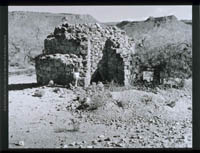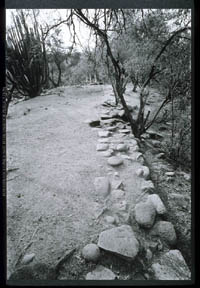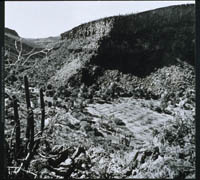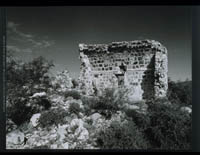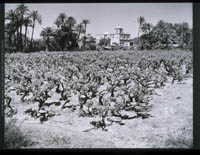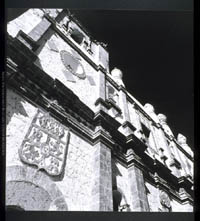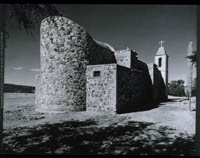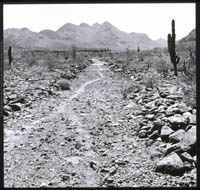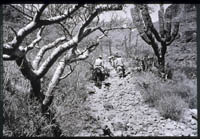|
| PREVIOUS 10... |
|
|
|
Misión de San
Javier de Biaundó, Located in a Mountain Area Called Viggé
continued...
- Lime
kiln midway between the mission at San Javier and San José
de Comondú, 1986
Jesuit Miguel del Barco had this kiln built in the 1740s
to calcine lime for the mortar used in building his elegant stone
church at San Javier. The kiln was dry-laid from volcanic rock fragments
and no doubt was used again a decade later when a stone church was
erected at Comondú.
- Foundations
of the church built at Misión de San José de Comondú
in 1716, 1990
The ruins of Padre Julián de Mayorga's church mark the mission's
original site at Comondú Viejo, some 20 airline miles north
of today's Comondú.
In 1714, Padre Mayorga and his soldier escorts staked out
the foundations pictured here. Comondú needed a church larger
and more permanent than the original small adobe erected in 1708.
Once again the material was adobe because no nearby source of lime
had been found and no masons were available to build with stone.
The width of twenty-one feet was dictated by the maximum length
of available rafter timbers. With deductions for three-foot thick
walls, the interior was only fifteen feet wide, but it was made
sixty-two feet long to accommodate the neophytes at this mission
headquarters. Padre Mayorga combined a sacristy and storehouse under
the same roof by extending the already hall-like plan an additional
twenty-five feet.
Neophyte laborers dug trenches and collected rocks of appropriate
shapes and sizes for the foundation. Foundation walls of fitted
and chinked stone were laid up to a height of two and a half feet,
that is, from the bottom of the trench to about a foot or more above
ground. When food was available to support labor, adobe blocks were
manufactured, and the side walls were gradually laid up to a height
of about ten feet. The end and intermediate walls were built even
higher into gable points to match the rafter angle and to bear the
ridgepole. Eight years after the founding of Misión de San
José, the roof-members were put up and the church was thatched.
- One
of the several agricultural plots developed at Misión de
San Jose de Comondú, 1967
Misión de San José's basic crops were wheat and corn.
In 1753 harvests were reported in precise figures: 72 tons of wheat
and 33 tons of corn. That harvest probably represented the mission's
needs for the year with perhaps a 20% surplus. However, climate,
soil, and water resources of the arroyo were better suited to orchards
and vineyards. Padre Juan de Ugarte initiated plantings as early
as 1714 and experimented with every available fruit. Certain trees
prospered and provided the cuttings or seed required to plant that
and other mission orchards. Principal successes were figs and grapes,
a basis for real trade because they yielded dried fruit and wine,
products that could be stored or transported. Oranges, pomegranates,
olives, lemons, and bananas also thrived and made important contributions
to otherwise limited mission diets.
In most years, Comondú's agricultural surpluses were
crucial to the survival of the California colony. The presidio often
had short-term food shortages. Several of the other missions were
never able to supply their own basic food needs and depended on
transfers from their more productive sisters.
- Ruins
of the chapel at the visiting station of Londó, 1990. Once
an important cattle ranch of Misión de Loreto
Londó was used as a watering and grazing station for the
horses, mules, and cattle brought to support Admiral Atondo's occupation
and exploration of the peninsula in 1684. In 1699, Jesuit Padre
Salvatierra established a visiting station, subordinate to his mission
at Loreto, to help in evangelizing the Cochimí who lived
in the area. In 1708, Londó was made a visiting station of
Misión de San José de Comondú, a mission devoted
exclusively to converting Cochim whereas Loreto principally addressed
the Monquí, a people of different culture and linguistic
stock. During the 1750s, Comondú became so depopulated due
to introduced diseases that Londó's valuable grazing lands
were returned to Loreto and became that mission and village's principal
source of beef.
|
|
|
|
|
|
|
|
|
The Mission Church at
San Ignacio
Jesuit Padre Jose Mariano
Rotea initiated work on San Ignacio's large, fine stone church in 1762. By 1768,
when the Jesuits were expelled, the walls had been raised to full height and
awaited a stone vaulted roof. In the confusion of successive Franciscan and
Domnican administrations of Antigua California's missions, construction stopped
until the 1780s when it was completed under the direction of the veteran Dominican
missionary, Juan Crisostomo Gomez.
- Grapevines
at Misión de San Ignacio, 1974. Long the most important of
the peninsula's wine producing missions.
Early in 1755, in a confidential report to his superior, Visitador
General José de Utrera noted that four California missions-
San Javier, San José de Comondú, La Purísima,
and San Ignacio together produced nearly 4,000 gallons of wine.
He reported that, in addition, San Javier, La Purísima, and
San Ignacio collectively produced 1,400 gallons of aguardiente (brandy).
Utrera did not visit in a year of exceptional yields; San Ignacio
was the biggest producer of both wine and brandy, but due to a flash
flood, the harvest of 1754 was only a third of what it had been
in each of the preceding two years. The magnitude of Utrera's figures
seems to belie the Jesuits' usual claim that peninsular missions
produced only enough wine for sacramental needs, or, in good years,
a small surplus they could sell or trade to help pay for embellishing
their churches or stocking their storehouses.
- Facade
of Misión de San Ignacio, 1967
- Great
Muralla, or dike at Misión de San Ignacio, 1971
Between 1750 and 1767, Jesuit Padres Fernando Consag and José
Mariano Rotea persuaded their neophytes to erect a massive wall
nearly two miles long in an effort to prevent flash floods from
Arroyo del Parral from washing away Misión de San Ignacio's
agricultural land.
- Misión
de San Luis Gonzaga, 1990
This small, simple, but sturdy church was built in the 1750s by
the German Jesuit, Padre Johann Jakob Baegert. Baegert, an important
chronicler of Jesuit California, spent seventeen years [1751-1768]
at the peninsula's loneliest, bleakest outpost to which he added
the only enduring monument.
|
|
|
|
|
|
|
|
|
Jesuit Road Building
to Facilitate the Mission Process
The Jesuits and
their employees struggled with California's broken, rocky terrain
as soon as they began to expand their enclave beyond Loreto. They
endured a painfully slow pace as their mounts moved over it. Plans
to build and maintain a main trail or camino real were made
early and followed faithfully throughout their seventy years on the
land. Once a mission site was chosen, a trail was cleared to connect
it with the nearest older establishment. Missions were located at
water sources, so Indian footpaths usually indicated the best routes
between them. Often the camino real was created simply by widening
and smoothing an old trail.
The Jesuits, or skilled soldiers or masons, laid out the camino real,
using stakes to indicate the sight lines of its course. Then soldiers
and neophyte men took over a formidable task. They cleared the larger,
loose stones out of the pathway and laid them in neat borders along
the sides. They levelled the path as much as possible, chipping away
protrusions from buried rocks, and filling holes with small debris.
They moved rocks weighing hundreds of pounds by using iron bars and
hardwood tree trunks as levers. They constructed switchback trails
on hillsides by clearing paths in the tumbled rocks. The floods of
the centuries have long since wiped the arroyo bottoms clean and eroded
many hillsides, yet on mesas and slopes in the volcanic mid-peninsular
region several dozen miles of these mission-period roads can still
be found.
- El
Camino Real midway between San Ignacio and Santa Gertrudis, 1967
- El
Camino Real in Arroyo del Infierno, 1971
William Decker, my son-in-law, took this picture of me and part
of our party as we rode on the ancient direct route from San Ignacio
to Santa Marta among fantastical forms of peninsular vegetation
torote [Bursera microphylla] on the left, and cardón [Pachycereus
pringlei] on the right.
|
|
|
|
|
|

